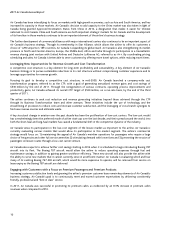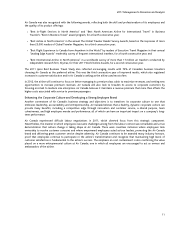Air Canada 2011 Annual Report Download - page 19
Download and view the complete annual report
Please find page 19 of the 2011 Air Canada annual report below. You can navigate through the pages in the report by either clicking on the pages listed below, or by using the keyword search tool below to find specific information within the annual report.
2011 Management’s Discussion and Analysis
19
Operating expenses increased 8% from 2010
Air Canada recorded operating expenses of $11,433 million, an increase of $879 million or 8% from the operating expenses of
$10,554 million recorded in 2010. The more significant variances are discussed below.
Fuel expense increased 27% from 2010
Fuel expense amounted to $3,375 million in 2011, an increase of $723 million or 27% from 2010. Factors contributing to the
year-over-year change in fuel expense included:
A higher base fuel price, which accounted for an increase of $973 million; and
A higher volume of fuel consumed, which was driven by the additional capacity year-over-year, and which accounted for
an increase of $93 million.
The above-noted increases were partly offset by the following:
Fuel hedging losses reclassified from AOCL of $183 million in 2010 versus no fuel hedging losses recorded in fuel expense
in 2011, resulting in a favourable variance of $183 million year-over-year; and
The favourable impact of a stronger Canadian dollar versus the U.S. dollar which accounted for a decrease of $160 million.
The table below provides Air Canada’s fuel cost per litre, excluding and including hedging, for the periods indicated.
Full Year Change
(Canadian dollars in millions, except where indicated) 2011 2010 $ %
Aircraft fuel expense – GAAP(1) $ 3,349 $2,638 $ 711 27
Remove: Fuel hedging losses reclassified from AOCL into fuel expense – (183) 183 100
Add: Net cash payments on fuel derivatives(2) 4 60 (56) (93)
Economic cost of fuel – Non-GAAP(3) $ 3,353 $2,515 $ 838 33
Fuel consumption (thousands of litres) 3,937,102 3,790,911 146,191 4
Fuel costs per litre (cents) – GAAP 85.1 69.6 15.5 22
Fuel costs per litre (cents) – excluding fuel hedging losses 85.1 64.8 20.3 31
Economic fuel costs per litre (cents) – Non-GAAP 85.2 66.4 18.8 28
(1) Excludes fuel expense related to third party carriers, other than Jazz, operating under capacity purchase agreements.
(2) Includes net cash settlements on maturing fuel derivatives and premium costs associated with those derivatives. Excludes early terminated hedging contracts of $5 million
in the second quarter of 2010 covering 2010 consumption.
(3) The economic cost of fuel is a non-GAAP measure used by Air Canada and may not be comparable to measures presented by other public companies. Air Canada uses this
measure to calculate its cash cost of fuel. It includes the actual net cash settlements from maturing fuel derivative contracts during the period and premium costs
associated with those derivatives. It excludes non-cash accounting gains and losses from fuel derivative instruments.
Wages, salaries and benefits expense amounted to $1,991 million in 2011, an increase of $78 million or 4% from 2010
Wages and salaries expense amounted to $1,533 million in 2011, an increase of $12 million or 1% from 2010, mainly due to
higher average salaries and an increase in the average number of FTE employees year-over-year. On capacity growth of 4.7%,
the average number of FTE employees increased 2.1% year-over-year, resulting in a productivity improvement of 2.5%, as
measured by ASMs per FTE employee. Partly offsetting these increases was a decrease in expenses related to incentive
compensation programs, including those linked to Air Canada’s operational performance.
Employee benefits expense amounted to $458 million in 2011, an increase of $66 million or 17% from 2010. The increase in
employee benefits expense was mainly due to higher pension and post-employment expenses resulting from changes in
actuarial assumptions year-over-year. The $66 million increase in employee benefits expense was slightly above the increase
of $60 million projected in Air Canada’s news release dated November 4, 2011.
























